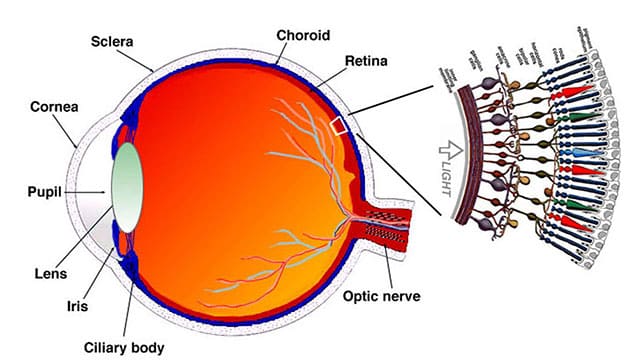What is the retina?
The retina is a thin layer of tissue containing nerve cells that lines the inside surface at the back of the eye.
Light enters through the cornea and the lens focuses the light. The retina then receives the light focused from the lens and turns it into neural signals. These signals are sent to the brain for visual recognition.
Layers of the retina
There are several major layers of the retina, and each layer serves a specific purpose essential for vision.
Choroid
A layer of the eye made up of blood vessels that supply oxygen and nutrients to the retina.
Retinal pigment epithelium (RPE) layer
A highly pigmented layer that provides oxygen and nutrients from the choroid to the photoreceptor cells.
The RPE also carries away waste products from the photoreceptors for disposal. If waste is not properly disposed and builds up it can cause Stargardt disease and macular degeneration.
Neural layer
Made up of photoreceptor cells, horizontal cells, bipolar cells, and ganglion cells that are all dependent on one another.
Photoreceptor cells. Light-sensitive cells made up of rods and cones that convert light into electrical signals.
- Rods. Found throughout the retina and are responsible for our peripheral vision and vision in low-light. If the rods are compromised it can cause vision loss called retinitis pigmentosa.
- Cones. Concentrated in the central part of the retina called the macula. The cones are responsible for our central and color vision. Macular degeneration is a loss of central vision from the cones in the macula.
Horizontal cells. Help increase your visual acuity by integrating and regulating the responses from multiple photoreceptors. Horizontal cells help the eyes to adjust under bright and dim light conditions.
Bipolar cells. Work with all the other cells of the retina to pass on information from the photoreceptors to the ganglion cells.
Ganglion cells. Responsible for carrying electrical information from the bipolar cells to the brain via the optic nerve. This information is processed to determine shapes, contrast, and color.

Conditions that affect the retina:
- Macular degeneration
- Retinitis Pigmentosa
- Stargardt disease
- Retinal detachment
- Diabetic retinopathy
- Retinopathy of prematurity
- Retinoblastoma
- Usher Syndrome
Routine eye exams are important for early detection of retinal problems.
